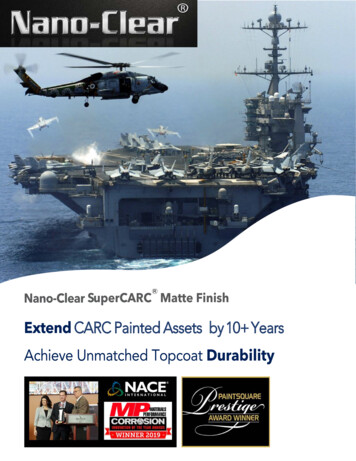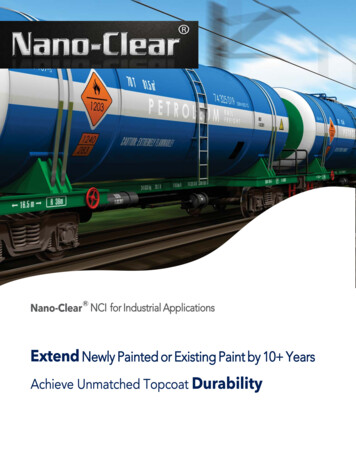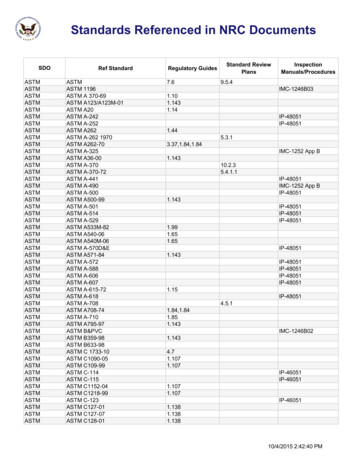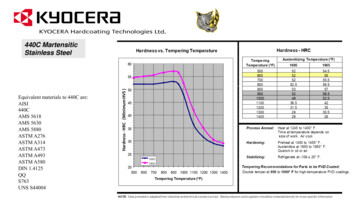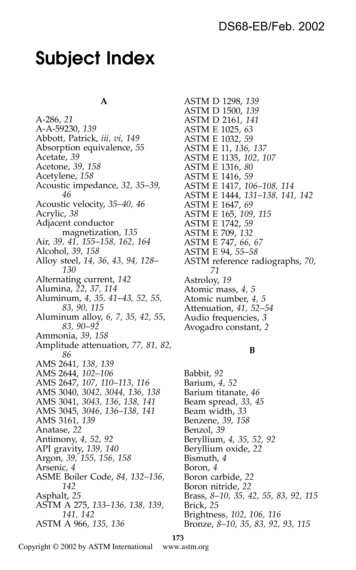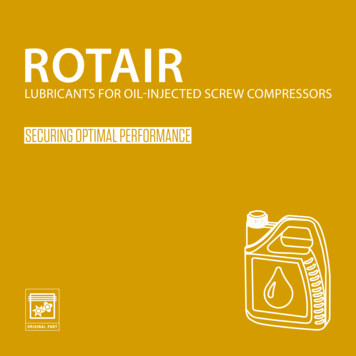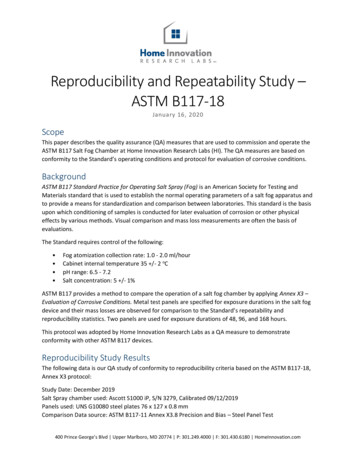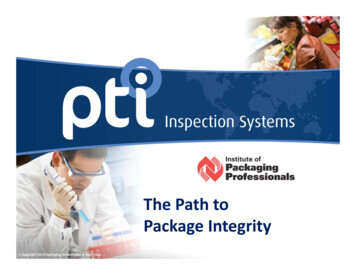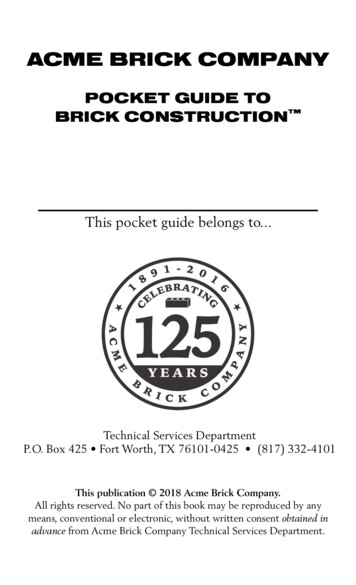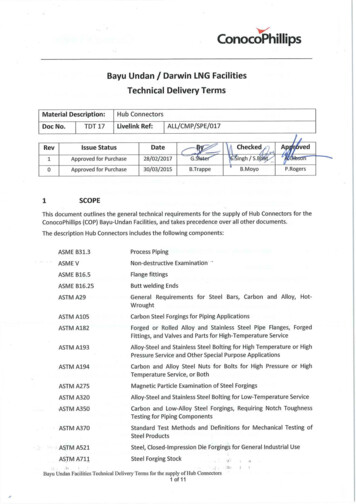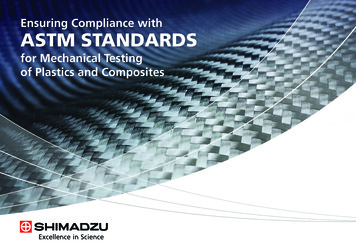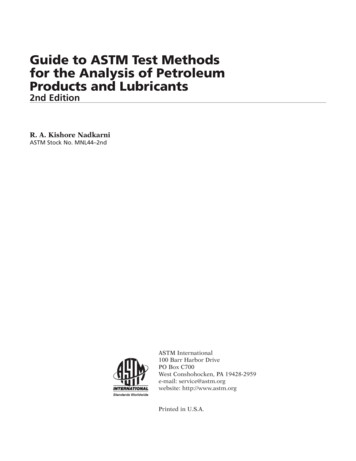
Transcription
Guide to ASTM Test Methodsfor the Analysis of PetroleumProducts and Lubricants2nd EditionR. A. Kishore NadkarniASTM Stock No. MNL44–2ndASTM International100 Barr Harbor DrivePO Box C700West Conshohocken, PA 19428-2959e-mail: service@astm.orgwebsite: http://www.astm.orgPrinted in U.S.A.
Library of Congress Cataloging-in-Publication DataNadkarni, R. A.Guide to ASTM test methods for the analysis of petroleum products and lubricants / R. A. Kishore Nadkarni–2nd ed.p. cm. 共ASTM manual series; no. mnl44-2nd兲Includes bibliographical references and index.ISBN 978-0-8031-4274-91. Petroleum products–Testing–Standards. 2. Lubrication and lubricants–Testing–Standards. I. Title.TP691.N33 2007665.5’380287-dc222007022845Copyright 2007 ASTM International, West Conshohocken, PA. All rights reserved. This material may not be reproducedor copied, in whole or in part, in any printed, mechanical, electronic, film, or other distribution and storage media,without the written consent of the publisher.Photocopy RightsAuthorization to photocopy item for internal, personal, or educational classroom use, or the internal, personal, oreducational classroom use of specific clients, is granted by ASTM International „ASTM provided that theappropriate fee is paid to the Copyright Clearance Center, 222 Rosewood Drive, Danvers, MA 01923; Tel: 978-7508400; online: http://www.copyright.com/.Printed in City, StateMonth 2007
How To Use This ManualTable I—lists the test methods with their equivalent IP, ISO, DIN, JIS, and AFNOR designations. The top of each pagelisting the test summary also refers to these equivalent standards. If you are considering using any standard that hasequivalent standards you should refer to them to determine the full scope of each standard and any differencesbetween. Although these standards are listed as equivalent they will not be exactly the same in many cases.Table II—lists the ASTM test methods alphanumerically by ASTM designation. If you know the ASTM designation, this isthe easiest way to find what you need. The top of each page listing the test summary also refers to these equivalentstandards.
ForewordTHE PUBLICATION, Guide to ASTM Test Methods for the Analysis of Petroleum Products and Lubricants: 2nd Edition, wassponsored by ASTM Committee D02 on Petroleum Products and Lubricants and edited by R. A. Kishore Nadkarni,Millennium Analytics, Inc., East Brunswick, NJ. This is Manual 44–2nd of ASTM’s manual series.This manual originally published in 2000 has proved to be a useful reference book to technologists and others in thePetroleum Products and Lubricants industry. This enlarged second edition is updated to include ASTM D02 Committeetest methods published through the end of 2006. The manual contains descriptions of a total of 585 test methods 共anincrease of 222 test methods from 363 methods in the first edition兲 describing a total of about 229 chemical and physicaltests used to analyze petroleum products and lubricants 共an increase of about 69 properties from about 160 propertiesdescribed in the first edition兲.The author and the publisher hope that this second edition will prove as useful as the first one to the oil industryresearchers, analysts, and marketers.
CONTENTSIntroductionExplanation of TermsTable I—Test Method EquivalenceTable II—Alphanumeric Index of StandardsAnalysis1236Reference ASTMStandardACID NUMBERby color indicator titration—see also Base number, p. 37by potentiometric titrationby semi-micro color indicator titrationby semi-quantitative micro determination of acid number of lube oils duringoxidation testingACIDITYin aviation turbine fuelof hydrocarbon liquids and their distillation residuesACTIVE SULFURin cutting oilsin fuels and solvents 共doctor test兲ADHESION OF SOLID FILM LUBRICANTSAIR RELEASE PROPERTIES OF OILSALKYL NITRATE IN DIESEL FUELSAMYL NITRATE IN DIESEL FUELSANALYSIS OF LPG AND PROPANE CONCENTRATES BY GCANILINE AND MIXED ANILINE POINTAPPARENT VISCOSITY – GENERALBorderline pumping temperature of engine oils—see p. 47Apparent viscosity by capillary viscometer at high temperature high shearHTHs by tapered bearing simulatorHTHs by tapered plug viscometerusing cold cranking simulatorat high temperature high shear by multicell capillary viscometerof lubricating greasesyield stress and apparent viscosity at low temperatureAPPLIED COATING WAX IN CORRUGATED BOARD FACINGAROMATICSand polynuclear aromatics in diesel and aviation turbine fuels by SFCin finished gasoline by gas chromatographyin finished gasoline by GCin finished gasoline by GC-FTIRin gasolines by gas chromatography-mass spectrometry 共GC-MS兲in hydrocarbon oils by high resolution nuclear magnetic resonance 共HR-NMR兲ASHin coal tar and pitchin petroleum cokefrom petroleum productssulfated ash from lubricating oils and additivesASPHALTENES 共HEPTANE INSOLUBLES兲 IN CRUDE PETROLEUM ANDPRODUCTSBASE NUMBERDDDD9746643339577017171919D 3242D 4D 97437vii
viii Guide to ASTM Test Methods: 2nd Editionin lubricants by color indicator titrationpotentiometric perchloric acid titrationby potentiometric HCl titrationBENZENE/TOLUENEin gasoline by gas chromatographyin gasoline by infrared 共IR兲 spectroscopyin finished gasoline by GC—see p. 30in finished gasolines by gas chromatography-mass spectrometry 共GC-MS兲—see p. 31in engine fuels using mid-IR spectroscopyAEROBIC, AQUATIC BIODEGRADABILITY OF LUBRICANTS IN ACLOSED RESPIROMETERBLOCKING AND PICKING POINTS OF PETROLEUM WAXBOILING RANGE DISTRIBUTIONof crude petroleum by gas chromatographyof gasoline by wide-bore capillary gas chromatographyby gas chromatographyof gasoline fractions by gas chromatographyof petroleum distillates by gas chromatographyof crude oils by high temperature gas chromatographyBORDERLINE PUMPING TEMPERATUREof engine oilsBROMINE NUMBERof distillates and aliphatic olefinsby electrometric titrationBURNING QUALITY OF KEROSENEBUTYLENE ANALYSIS BY GCCARBON, HYDROGEN, AND NITROGEN DETERMINATION—see p. 186CARBON NUMBER DISTRIBUTIONCARBON RESIDUEby micro methodCARBONIZABLE SUBSTANCESin paraffin waxin white mineral oilCARBONYLS IN C4 HYDROCARBONSCARBONYL SULFIDE IN PROPYLENEby gas chromatographyCETANE NUMBER DERIVED, OF DIESEL FUEL OILSCHLORINEbomb methodfield test kit method for chlorine in used petroleum productsorganic chloride in crude oilin lubricating oils and additives by wavelength dispersive x-ray fluorescence共WD-XRF兲—see p. 176CLOUD POINTof petroleum products, manualauto-optical detection stepped cooling method—see p. 55auto-linear cooling rate method—see p. 55auto-constant cooling rate method—see p. 55COEFFICIENT OF FRICTION OF LUBRICANTSOF LUBRICATING GREASECOEFFICIENT OF KINETIC FRICTION FOR WAX COATINGSCOKING VALUE OF TAR AND PITCHD 5984D 2896D 4739373838DDDD36064053558057693939D 6277D 67314040D 146541DDDDDD530770967213371063527169414243444546D 382947DDDDDD1159271018744245291288748484849D 453051D 612D 565D 4423515152D 5303D 71705253DDDD808538449296443545455DDDDDDDDD5771/D 5772/D 57732500577157725773518357072534471555564956575758
COLD CRANKING SIMULATORapparent viscosity using manual cold cranking simulatorusing cold cranking simulator—see p. 26COLD FILTER PLUGGING POINT 共CFPP兲of diesel and heating fuelsCOLORASTM colorof dyed aviation gasolineGardner colorplatinum-cobalt colorSaybolt colorby automatic Tristimulus methodCONE PENETRATIONof lubricating greasesof lubricating greaseof petrolatumCONGEALING POINTof petroleum waxes and petrolatumCONRADSON CARBON RESIDUEof petroleum productsof tar and pitchCOOLING CHARACTERISTICS OF QUENCH OILS BY COOLING CURVEANALYSISCOPPER IN JET FUELS BY GRAPHITE FURNACE ATOMIC ABSORPTIONSPECTROMETRYCOPPER CORROSIONby copper strip tarnishby liquefied petroleum gasesfrom lubricating greasefrom petroleum productsof solid film lubricantsCORROSIVENESS OF DIESEL OILS AT 135 CCORROSION PREVENTIVE PROPERTIEScorrosiveness and oxidation stability of oilsCORROSIVENESS OF LUBRICATING FLUIDof hydraulic oilsof lubricating greasesof lubricating greasesof lubricating greases 共EMCOR test兲CRYSTALLINE SIZE OF CALCINED PETROLEUM COKEby x-ray diffractionDEMULSIBILITY CHARACTERISTICS OF LUBRICATING OILSDENSITY, RELATIVE DENSITY, AND SPECIFIC GRAVITY – GENERALreal density of calcined petroleum cokevibrated bulk density of calcined petroleum cokereal density of calcined petroleum cokegravity, specificby digital metersof light hydrocarbons by pressure thermohydrometerof liquids by Bingham pycnometergravity, specificof solid pitch by pycnometerof solid pitch by pycnometerD 2602D 529358D 637159DDDDDD15002392154412091566045606262626363D 217D 1403D 937646465D 93865D 189D 2416D 6200666869D 272D 463673DDDD654717435969613874747475D 5187D 045002405216571217129823204892ix
x Guide to ASTM Test Methods: 2nd Editionof solid pitch and asphaltby Stabinger viscometerby thermohydrometer methodof viscous materials by Bingham pycnometerof viscous materials by Lipkin pycnometerDEPENTANIZATIONof gasoline and napthasDIESEL FUEL DILUENTin used diesel engine oils by gas chromatographyDISTILLATION – GENERALof crude petroleumof heavy hydrocarbon mixturesof petroleum productsat reduced pressureof pitchDIMETHYLFORMAMIDE OF TAR AND PITCHDOCTOR TEST—see p. 21DROPPING POINT – GENERALof lubricating greaseof lubricating greaseDUST CONTROL MATERIALon calcined petroleum cokeELASTOMER COMPATIBILITYof lubricating greases and fluidsELECTRICAL CONDUCTIVITYof Aviation and Distillate fuelsof liquid hydrocarbons by precision meterENGINE OIL VOLATILITYby capillary gas chromatographyby Noack evaporation—see p. 96by TGA—see p. 97ETHANOL CONTENTin denatured fuel ethanol by GCETHYL MERCAPTAN IN LPG VAPORETHYLENE GLYCOL IN USED ENGINE OILEVAPORATION LOSSES BY VOLATILITY – GENERALby GCof lubricating greasesof lubricating greases and oilsNoack evaporation lossby thermogravimetric analysis 共TGA兲 noack methodEXPLOSIVE REACTIVITY OF LUBRICANTSEXTREME PRESSURE PROPERTIESof fluid lubricantsof lubricating fluidsof lubricating fluidsof lubricating greaseof lubricating greasesof solid bonded filmsEXTRACTABLESsolvent extractables in petroleum waxesFILTER PLUGGING TENDENCYof distillate fuel oilsDDDDD7170426822148014818181828383D 200184D 952D 566D 2265898990D 493090D 428990D 2624D 43089192D 6417D 5800D 637593D 5501D 5305D 798DDDDDD323327822783259657067217989999100100101D 3235101D 2068102
FILTERABILITY OF AVIATION TURBINE FUELFILTERABILITY OF DIESEL FUELSFILTERABILITY OF DISTILLATE FUEL OILSFILTERABILITY OF ENGINE OILS AFTER TREATMENT WITH WATERFILTERABILITY OF ENGINE OILS AFTER TREATMENT WITH WATERAND DRY ICEDISCRIMINATION BETWEEN FLAMMABILITY RATINGSFUEL INJECTOR SHEAR STABILITY TEST 共FISST兲FLASH POINT – GENERALby continuously closed cup tester 共CCFP兲by cleveland open cup 共COC兲by MCCFP testerby small scale closed cup tester 共ramp method兲by Pensky-Martens closed tester 共PMCC兲small scale closed testerTag closed testerFLOCCULATION RATIO AND PEPTIZING POWER IN RESIDUAL ANDHEAVY FUEL OILSFOAMING TENDENCYin aqueous mediain aqueous mediaof lubricating oilshigh temperature foaming tendencyFREEZING POINTof aviation fuelsof aviation fuels 共automatic fiber optical method兲by automatic laser methodby automatic optical methodby automatic phase titration methodof high purity hydrocarbonsFRETTING WEAR PROTECTIONby lubricating greasesFRICTION AND WEAR PROPERTIESof extreme pressure lubricating oilsFUEL SYSTEM ICING INHIBITORS IN AVIATION FUELSGAGE VAPOR PRESSURE OF LPGGASOLINE DILUENT IN USED ENGINE OILSdistillation methodgas chromatography methodGLYCERIN IN BIODIESEL METHYL ESTERS BY GCGLYCOL ANTIFREEZE IN USED LUBRICATING OILSGRAIN STABILITY OF CALCINED PETROLEUM COKEGRAVITY, API BY HYDROMETER METHODEXISTENT GUM IN FUELS BY JET EVAPORATIONHARDGROVE GRINDABILITY INDEX OF PETROLEUM COKEHEAT OF COMBUSTION OF PETROLEUM PRODUCTSnet heat of combustion of aviation fuelsof aviation fuelsof aviation fuelsof aviation fuelsnet and gross heat of combustion of burner and diesel fuelsheating values of liquids and solids by differential mackey testof liquid hydrocarbon fuels by bomb 4D 6668D D 4170116D 6425D 5006D 83523240122122122123123123124xi
xii Guide to ASTM Test Methods: 2nd Editionof liquid hydrocarbon fuels by bomb calorimeterliquid heat capacity of petroleum distillate fuelsspecific heat of aircraft turbine fuels by thermal analysisSEPARABILITY NUMBER OF HEAVY FUEL OILSby optical scanning deviceHIGH TEMPERATURE DEPOSITS BY TEOSTHIGH TEMPERATURE STABILITYof distillate fuelsHIGH TEMPERATURE UNIVERSAL OXIDATION TEST FOR TURBINEOILSHINDERED PHENOLIC AND AROMATIC AMINE ANTIOXIDANTCONTENT IN NON-ZINC TURBINE OILSby linear sweep voltammetryHINDERED PHENOLIC ANTIOXIDANT IN HL TURBINE OILSby linear sweep voltammetryHOMOGENITY AND MISCIBILITYof engine oilsHYDROCARBON TYPES – GENERALcharacteristic groups in oils by clay-gel absorption chromatographyaromatics and nonaromatics fractions of high boiling oils by emulsionchromatographyby fluorescent indicator adsorptionin gasoline by gas chromatographyin ethylene by gas chromatographyHYDROCARBON TYPES IN ENGINE FUELSby gas chromatographyby mass spectrometryaromatics types by mass spectrometryaromatic hydrocarbon types in aviation fuels and petroleum distillatesAROMATIC HYDROCARBON TYPES IN MIDDLE DISTILLATESby HPLC with RI detectionby mass spectrometryin gasoline by mass spectrometryby multidimensional GCHYDROGEN CONTENT OF FUELS – GENERALof aviation fuelsof aviation turbine fuels by low resolution nuclear magnetic resonance 共NMR兲of petroleum products by low resolution NMRby NMRof petroleum fractionsof carbon, hydrogen, and nitrogen—see p. 186HYDROLYTIC STABILITYHYDROGEN SULFIDEin liquefied petroleum gas 共LPG兲 by lead acetate methodin residual fuelsin residual fuel oilsHYDROPEROXIDE NUMBERof aviation turbine fuelsHYDROXYL NUMBERINDIVIDUAL COMPONENTS IN ENGINE FUELSby high resolution gas chromatographyby high resolution gas chromatographyby high resolution gas chromatographyD 4809D 2890D 4816124125125D 7061D 6335126126D 6468D 6514127127D 6971128D 6810129D 6922D 2007D 2549129130130131D 1319D 2427D 137138139139140140141141141142142D 2420D 6021D 5705143143144D 6447D 1957144145D 6729D 6730D 6733145146148
INSOLUBLES IN HYDRAULIC FLUIDSPENTANE INSOLUBLESby membrane filtrationINSOLUBLES IN HYDRAULIC FLUIDSin used lubricating oilsin used oilsIODINE NUMBERIRON CHIP CORROSIONfor water dilutable metal working fluidsLEAD DETERMINATION IN GASOLINE – GENERALby atomic absorption spectrometry 共AAS兲in gasoline by iodine chloride 共ici兲 methodin gasoline by x-ray fluorescence 共XRS兲for trace lead in gasolineLEAKAGE TENDENCIESof automotive greasesLEAKAGE TENDENCIES OF GREASESLIFE PERFORMANCE OF GREASESLINEAR FLAME PROPAGATION RATEof lube oils and hydraulic fluidsLITHIUM AND SODIUMin greases by flame photometerLOAD-CARRYING CAPACITY OF GREASESLOW TEMPERATURE FLUIDITY AND APPEARANCEof hydraulic fluidsLUBRICATING GREASES ANALYSISLUBRICITY OF AVIATION TURBINE FUELSLUBRICITY OF DIESEL FUELSby high-frequency reciprocating rig 共HFRR兲LUMINOMETER NUMBERSof aviation turbine fuelsMANGANESE IN GASOLINE BY AASMELTING POINT OF PETROLEUM WAXDROP MELTING POINT OF PETROLEUM WAXMERCAPTAN SULFURin petroleum productsMISTING PROPERTIES OF LUBRICATING FLUIDSMETAL ANALYSIS BY SPECTROSCOPY – GENERALTRACE METALS IN GAS TURBINE FUELS BY AA/FESin lubricating oils by AASaluminum and silicon in fuel oils by inductively coupled plasma 共ICPAES兲 andAASTRACE ELEMENTS IN MIDDLE DISTILLATE FUELSby ICP-AESin oils and fuels by flame AASICP-AES, standard practice for operationCONTAMINANTS IN GAS TURBINE AND DIESEL ENGINE FUELS BYROTRODEINDUCTIVELY COUPLED PLASMA ATOMIC EMISSION SPECTROMETRYinductively coupled plasma atomic emission spectrometrymetals in greasein crude oils and fuels by ICP-AESD 4898148D 4055149D 893D 7317D 2078149150150D 46273237334150593348151151151152152153D 1263D 4290D 3527153153154D 5306154D 3340D 2509155155D 6351D 128D 5001156156156D 6079157DDDD1740383187127157158158159D 3227D 3705D 3605D 4628D 5165DDDD4951518573035708167168169170DDDDxiii
xiv Guide to ASTM Test Methods: 2nd EditionPHOSPHORUS IN ILSAC GF4 ENGINE OILSby ICP-AESin petroleum coke by AASin petroleum coke by ICPAESin petroleum coke by wavelength dispersive x-ray spectroscopyWEAR METALS AND CONTAMINANTSin used oils/hydraulic fluids using rotrode emission spectrometryx-ray fluorescence spectrometryin lubricating oils and additives by wavelength dispersive x-ray fluorescence共WD-XRF兲METALS IN LUBRICATING OILSby energy dispersive x-ray fluorescence spectroscopyMETHANOL IN CRUDE OILSby multi-dimensional gas chromatographyTRACE METHANOL IN PROPYLENE CONCENTRATESby gas chromatographyMOLECULAR WEIGHTof lubricating oilsof hydrocarbonsof petroleum oilsMOISTURE CORROSION RESISTANCEof automotive gear lubricantsMOISTURE OF GREEN PETROLEUM COKEMETHYL TERT-BUTYL ETHERby gas chromatographyin gasoline by GCOXYGENATESin gasoline by gas chromatography—see p. 198in finished gasoline by GC-FTIR—see p. 30in gasoline by infrared spectroscopyNAPTHALENE HYDROCARBONSin aviation turbine fuels by ultraviolet 共UV兲 spectrophotometryNEEDLE PENETRATION OF PETROLEUM WAXEStrace nitrogen by oxidative combustion and chemiluminescence detectionby boat-inlet chemiluminescenceof carbon, hydrogen, and nitrogenKjeldahl methodODOR OF PETROLEUM WAXAUTOMOTIVE ENGINE OIL COMPATABILITYwith typical seal elastomersOIL CONTENT OF PETROLEUM WAXESOIL SEPARATION FROM GREASEby centrifuging 共Koppers method兲OIL SEPARATION FROM GREASE 共CONICAL SIEVE METHOD兲o-PONA hydrocarbons in fuels by GC—see p. 199OLEFINS IN ENGINE FUELSby GCOLEFINS IN GASOLINESby supercritical fluid chromatographyby fluorescent indicator adsorption—see p. 131OXIDATION INDUCTION TIME OF GREASESOXIDATION INDUCTION TIME OF LUBE OILSby pressure differential scanning calorimetry 共PDSC兲DDDD7040505656006376171172173173D 6595D 4927D 6443174175176D 6481177D 7059178D 4864178D 2878D 2503D 2502179179180D 7038D 4931180181D 5441D 4815181182D 5599D 5986D 4185186186187D 7216D 721187188D 4425D 6184D 6293188189D 6296189D 6550D 1319D 5483190D 6186191191
OXIDATION OF USED LUBRICANTSby FT-IR using peak area increase calculationOXIDATION STABILITYof aviation fuelsof distillate fuelsof oils by thin film oxygen uptake 共TFOUT兲of extreme pressure lubricating oilsof gasolineof gear oilsof inhibited mineral oilsof lubricating greasesof oils by universal oxidation testOXIDATION STABILITY OF STEAM TURBINE OILSby rotating pressure vesselOXYGEN IN GASOLINE AND FUELSby reductive pyrolysisin gasoline by GC—see p. 182in gasoline by gas chromatographyin finished gasoline by GC-FTIR—see p. 30o-PONA hydrocarbons in fuels by GCPARTICULATE CONTAMINATIONin aviation fuelsin aviation fuelin middle distillate fuelsPEROXIDES IN BUTADIENEPOLYCHLORINATED BIPHENYLS 共PCBs兲 IN WASTESby gas chromatographyPEROXIDE NUMBERof aviation turbine fuelsof petroleum waxPETROLEUM WAX ANALYSISby GCPHOSPHORUS DETERMINATION IN PETROLEUM PRODUCTSPHOSPHORUS DETERMINATIONin gasolineby ICP-AES in GF4 oils—see p. 171in lubricating oilsin lubricating oilsPISTON DEPOSITSby TEOST MHTPOUR POINT OF CRUIDE OILSPOUR POINT, MANUALPOUR POINTby using automatic air pressure methodauto pour point 共phase technology兲auto pour point 共ISL兲auto robotic tilt methodauto pour point 共Herzog兲PRECIPITATION NUMBER OF LUBRICATING OILSPUMPABILITY OF INDUSTRIAL FUEL OILSQUENCHING TIME OF HEAT TREATING FLUIDSQUINOLINE INSOLUBLE CONTENTof tar and pitchD 2193193194195195196196197D 75799200200201201D 6160202D 3703D 1832202203D 5442203DDDD3231704010914047204D 7097D 5853D 10211211212212213213213D 2318214198199205207xv
xvi Guide to ASTM Test Methods: 2nd EditionQUINOLINE INSOLUBLE IN TAR AND PITCHby pressure filtrationRAMSBOTTOM CARBON RESIDUERED DYE CONCENTRATION AND ESTIMATION OF ASTM COLORRED DYE CONCENTRATION AND ESTIMATION OF SAYBOLT COLORREFRACTIVE INDEXof hydrocarbon liquidsof viscous materialsRESIDUES IN LIQUEFIED PETROLEUM GASESROLL STABILITY OF LUBRICATING GREASESRUST PREVENTIVE CHARACTERISTICSof engine oilsof mineral oilsof steam turbine oilSALTS IN CRUDE OILSALT IN CRUDE OILSSAPONIFICATION NUMBERSEDIMENT TESTSsediment in crude and fuel oilsin crude oilin trace sediment in lubricating oilsin crude oilwater and sediment in crude oilwater and sediment in middle distillate fuelsLUBRICITY OF DIESEL FUELS BY SLBOCLESONIC SHEAR STABILITYshear stability indexof polymer-containing fluidsof hydraulic fluidof polymer-containing oilsSHEAR STABILITY OF POLYMER CONTAINING FLUIDS USING AEUROPEAN DIESEL INJECTOR APPARATUSSLUDGING AND CORROSION TENDENCIESof inhibited mineral oilsSMOKE POINTof kerosene and aviation turbine fuelSOFTENING POINT OF ASPHALT AND PITCH – GENERALmettler cup-and-ball methodcube-in-water methodcube-in-air methodmettler softening point methodSOLIDIFICATION POINT OF PETROLEUM WAXSOLVENT RED DYE 164 IN DIESEL FUELSSTABILITY AND COMPATIBILITY OF HEAVY FUEL OILS AND CRUDEOILS BY OIL STABILITY ANALYZER 共OPTICAL DETECTION兲STABILITY, STORAGEdistillate fuel storage stability at 43 cdistillate fuel storage stabilityINTRINSIC STABILITY OF ASPHALTENE CONTAINING OILSstability of residual fuels by spot teststorage stability of water-in-oil emulsionsstability of water-in-oil emulsionssulfate, inorganic in ethanol by potentiometric 7227228228D 4310229D 33234234235235236236
sulfate & chloride, inorganic in ethanol by DIICsulfate & chloride in ethanol by AIICSULFATED ASH FROM LUBRICATING OILS AND ADDITIVES—see p. 34SULFONATES BY LIQUID CHROMATOGRAPHYSULFUR DETERMINATION IN PETROLEUM PRODUCTS – GENERALin cutting oils—see p. 21in fuels and solvents 共Doctor test兲—see p. 21sulfur determination by bomb methodby high temperature methodby hydrogenolysis and rateometric colorimetryby lamp methodin liquid petroleum gases 共LPG兲in petroleum products—see p. 159by monochromatic WDXRFby on-line GC with FPDby oxidative combustion and electrochemical detectionby oxidative combustion with electrochemical detectionby EDXRF using a low background proportional counterin fuels by polarization XRFby oxidative microcoulometryby oxidative microcoulometryby GC-sulfur detectorby ultraviolet fluorescence methodTOTAL VOLATILE SULFURin gaseous hydrocarbons and LPG using combustion UV fluorescencedetectionsulfur by wavelength dispersive x-ray fluorescence 共WD-XRF兲by energy dispersive x-ray fluorescence 共ED-XRF兲in gasoline by energy-dispersive x-ray fluorescence spectrometryin gasoline by WD-XRFby TFOUT catalyst BSURFACE WAX COATING ON CORRUGATED BOARDSURFACE WAX ON WAXED PAPER OR PAPERBOARDTHERMAL CONDUCTIVITY OF LIQUIDSTHERMAL STABILITYof aviation turbine fuels by JFTOT procedureof aviation turbine fuels by HIRETS methodTHERMAL STABILITYof organic heat transfer fluidsof hydraulic oilsINSTABILITYof middle distillate fuels by portable spectrophotometerof solid film lubricantsof way lubricantsTOLUENE INSOLUBLES IN TAR AND PITCHTOLUENE INSOLUBLES IN TAR AND PITCHTORQUE, LOW TEMPERATUREof ball bearing greaseof grease lubricated wheel bearingsTOTAL INHIBITOR CONTENTof light hydrocarbonsTRANSITION TEMPERATURES OF PETROLEUM WAXES BY DSCULTRAVIOLET 共UV兲 ABSORBANCE OF PETROLEUM 45246246247247248248249D 251252252253253254254D 3241D 6811255255D 6743D D 1478D 4693259259D 1157D 4419D 2008260260261xvii
xviii Guide to ASTM Test Methods: 2nd EditionUNSULFONATED RESIDUEof oilsVANADIUM IN HEAVY FUEL OILVAPOR LIQUID RATIOof fuelstemperature of fuelsVAPOR PRESSUREof crude oilof gasoline and blendsof LPG 共expansion method兲of lubricating oils—see p. 179of petroleum products by automatic methodof petroleum products by mini-automatic methodof petroleum products by mini-atmospheric methodREID vapor pressure of petroleum productsof petroleum products by triple expansion methodVISCOSITY, APPARENTapparent viscosity by capillary viscometer at high temperature high shear—seep. 25using cold cranking simulator—see p. 26of hot melt adhesivesat high temperature high shear by multicell capillary viscometer—see p. 26of lubricating greases—see p. 27of petroleum waxesYIELD STRESS AND APPARENT VISCOSITYof used engine oils at low temperatureyield stress and apparent viscosity at low temperature—see p. 27LOW TEMPERATURE VISCOSITY OFdrive line lubricants in a constant sheer stress viscometer—see p. 275VISCOSITYBrookfield viscosityscanning Brookfield viscosityHouillonat high temperature high shear—see p. 25at high shear rate by tapered bearing simulator viscometer at 100 cat high shear rate by tapered plug-simulator—see p. 26VISCOSITY INDEX, CALCULATIONSVISCOSITY, KINEMATICof aircraft turbine lubricantsof transparent and opaque liquidsVISCOSITY, MINI-ROTARYof volatile and reactive liquidsof engine oils—see p. 47VISCOSITY, SAYBOLTof drive line lubricants in a constant sheer stress viscometerROTATIONAL VISCOSITY OF HEAVY DUTYdiesel drain oils at 100 cVISCOSITY, SAYBOLTuniversal viscosityVISCOSITY, SHEARof coal-tar and petroleum pitchesDYNAMIC VISCOSITY AND DENSITY BY STABINGER VISCOMETER—see p. 81D 483D 1548262262D 2533D 9154823236378265265266266267D 4624DDDDD52933236548110922669D 6896D 4684267268269D 6821DDDDDDD2983513372794683661647412270269270271D 2532D 445273273DDDD27427127244863829886821275275D 6895276D 2161276D 5018D 7042277
VISCOSITY-TEMPERATURE RELATIONSHIP OF USED AND SOOTCONTAINING ENGINE OILSVOLATILEScontaminants in used engine oilsin gaseous hydrocarbons and lpg using combustion UV fluorescencedetection—see p. 250matter in green petroleum cokematter in petroleum cokepitch volatilityVOLATILITYof LPGWATER – GENERALin crude oils by coulometric KF titrationin crude oil by distillationin crude oils by potentiometric KF titrationFREE WATER, PARTICULATES, AND CONTAMINANTSin aviation fuelsin distillate fuelsin mid-distillate fuelsin petroleum products and lubricants by coulometric Karl Fischer titrationin petroleum products by distillation methodby Karl Fischer reagentreaction of aviation fuelsresistance of lubricating greaseand sediment in crude oil—see p. 225and sediment in fuel oilsand sediment in crude oilwater separation of diesel fuelsand sediment in middle distillate fuels—see p. 225separation characteristics of aviation turbine fuelsseparability of petroleum oilswater spearation characteristics of kerosene-typeby portable separometersolubility in hydrocarbons and aliphatic ester lubricantsin solvents by Karl Fischer titrationtolerance of gasoline-alcohol blendsundissolved in aviation turbine fuelswashout characteristics of lubricating greasesWAX APPEARANCE POINTof distillate fuelsWAX APPLIED DURINGcurtain coating operationWAX CONTENT OF CORRUGATED PAPERBOARDWEAR CHARACTERISTICS OF PETROLEUMhydraulic fluidsWEAR CHARACTERISTICSof non-petroleum and petroleum hydraulic fluidsof lubricating fluid 共four ball method兲preventing properties of lubricating greasesof lubricating grease 共four ball method兲of hydraulic fluidsWEAR LIFEof solid film lubricantsof tractor hydraulic fluidsD 7110277D 3607D 6667278D 6374D 4421D 4893278279279D 1837279280282282283D 4928D 4006D DDDDD722440561364642232401264291292292293293294D 3117294D 3708D 3344294295D 6973295DDDDD70434172370422662882296296297297298D 2981D 4998298299287288288289290xix
1INTRODUCTIONCRUDE OILS, petroleum products and lubricants are highlycomplex materials and enormous efforts have been spent bythe oil companies throughout the world to characterize theirchemical and physical properties with a high degree ofprecision and accuracy. The explosive growth in theavailability of modern analytical instrumentation in the lastfour to five decades has significantly helped in the task ofpetroleum products analyses. These modern techniques havelargely supplanted the classical “wet chemistry” types ofanalyses, which were used in the first half of the last century[1, 2]. However, there are still a few areas where somespecific analyses need these older techniques.ASTM Committee DO2 Petroleum Products and Lubricantshas since the last century led these efforts to develop morereliable and standard test methods to the point that in allcorners of the world ASTM DO2 standards are considered asthe final arbitrators of the quality of a petroleum relatedproduct. Other national and international standardizationbodies such as EI (formerly called IP) in U.K., AFNOR inFrance, DIN in Germany, JIS in Japan, and ISO have alsocontributed significantly in developing standard test methodsfor the analyses of petroleum products. However, many ofthe latter standards are based on the ASTM DO2 standards
by Stabinger viscometer D 7042 81 by thermohydrometer method D 6822 82 of viscous materials by Bingham pycnometer D 1480 83 of viscous materials by Lipkin pycnometer D 1481 83 DEPENTANIZATION of gasoline and napthas D 2001 84 DIESEL FUEL DILUENT in used diesel engine oils by gas chromatography D 3524 84 DISTILLATION - GENERAL 84
